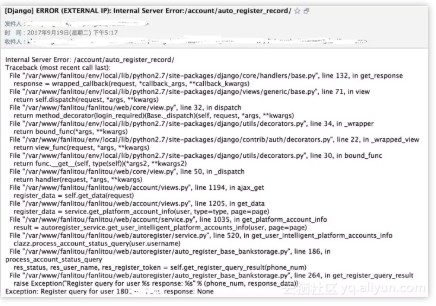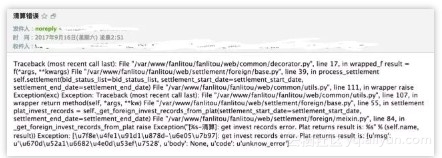Python | 5分鐘教你學會Django系統錯誤監控
阿新 • • 發佈:2018-11-02
話不多說,直入正題。
先上圖,看一下監控的效果。
如下是監控我們網站系統錯誤的郵件。包含了請求的url地址,以及詳細的異常資訊。

一、監控所有的request請求
如何實現系統監控,自動傳送錯誤日誌的郵件呢?只需配置配置settings檔案即可。
1.設定傳送郵件配置資訊
郵件會發送到ADMINS設定的郵件列表中。
SERVER_EMAIL ='[email protected]'
DEFAULT_FROM_EMAIL ='[email protected]'
ADMINS = (('receiver','[email protected]'),)
EMAIL_HOST ='smtp.exmail.qq.com'
EMAIL_HOST_USER =' 2.配置LOGGING
1)配置mail_admin的handler
level為日誌級別
django.utils.log.AdminEmailHandler為django處理系統日誌傳送郵件的handler
在沒有配置filter引數情況下,預設傳送系統5XX狀態的錯誤日誌
'handlers': { 'mail_admin': { 'level':'ERROR', 'class':'django.utils.log.AdminEmailHandler', 'include_html':False, } }
2)配置django.request模組的logger
將django的request模組配置如上的mail_admin handler
'loggers': {
'django.request': {
'handlers': ['default','mail_admin'],
'propagate':True,
'level':'ERROR',
},
}二、監控非request請求
如何監控例如系統的定時任務等非使用者發起的功能模組,我們可以自定義一個decorator來解決這個問題。
utils.send_exception_email(email_list,title,exc)為傳送郵件的方法,可以自己實現,非常簡單
def decorator_error_monitor(title):
def wrap(f):
def wrapped_f(*args, **kwargs):
try:
result = f(*args, **kwargs)
return result
except:
exc = traceback.format_exc()
utils.send_exception_email(email_list, title, exc)
raise Exception(exc)
return wrapped_f
return wrap對需要監控的方法使用decorator
@decorator_error_monitor("清算錯誤")
def do_settlement(users):
for user in users:
process_settlement_for_one_user(user)
小結
以上監控方法,簡單實用,無需開發額外的日誌監控系統,可以在第一時間發現系統的問題,並得知系統的錯誤日誌,幫助快速的定位問題。
原文釋出時間為:2018-10-31
本文作者:上海小胖
